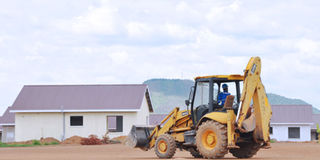Pool resources, switch to mechanised farms - JCB boss

A man uses a grader ahead of construction works of Kabaale Airport in Hoima district. Smallholder farmers are advised to get together and purchase a machine that can assist them to mechanise operations. PHOTO BY ERONIE KAMUKAMA
What you need to know:
Smallholder farmers can hardly afford the expensive mechanisation equipment. This is considered the biggest obstacle to smallholder farmers who want to adopt mechanised farming. Prosper Magazine’s Christine Kasemiire engages Mr Altaf Ganatra, JCB Group managing director, on how these smallholder farmers can team up to access the desired funds.
Briefly tell us about JCB Ganatra?
JC Bamford Excavators Limited (JCB) is a company that was started in 1945 as a small family business in the United Kingdom. Currently, it is the third largest manufacturer of construction machinery in the world. It is the largest privately owned company with a product range of more than 300 machines across different sectors such as construction, waste management, agriculture and mining.
In Africa, we have operations in Uganda, Tanzania, Zimbabwe, South Africa and Kenya among others. We have spent a little over the year in Uganda.
What is the state of Uganda’s market in respect to demand for machinery?
The market is buoyant. We see a lot of optimism since people are gearing up for a booming infrastructure development with most of it based in oil and gas. Refurbishment and construction of roads is also a sign of positive development and we feed into that either directly or indirectly.
You mentioned production for different sectors, which sectors in Uganda predominantly use machinery?
The first we always fit into is construction. We also do quite a bit with agriculture, for instance, Uganda has many sugar companies that require machines for loading in the factories. While agriculture is a major sector, our main focus is on construction.
How receptive is the agricultural sector towards mechanisation?
Subsistence farming in Uganda is mainly made up of smallholder farmers who will not require machines since they are mainly labour based. Demand in agriculture mainly comes from large scale agriculturalists where mechanisation is required to quicken the tasks. Our demand mainly comes from sugar, tea, coffee companies and horticulture. Horticulture utilises most our machinery especially for expansion when putting up irrigation, loading and off-loading plus applying fertiliser. It will be a long time before we see mechanisation in smallholder and subsistence farming.
Is there something that can be done to mechanise smallholders and subsistence farmers?
Borrowing from the Kenyan model, you find that many people come together. A few farmers, smallholders get together and purchase a machine that can assist them. It has the semblance to Saccos. They get together, pool resources and mechanise in a certain way so it benefits the whole area and group.
How does Uganda compare to Kenya in mechanisation?
They are two different countries. Kenya, because of an already good infrastructure development, has a lot of work there.
In Uganda, you see a lot more work being started up in infrastructure development at the moment and because of the anticipated oil and gas.
While Kenya also has a bit of oil and gas, it is not as extensive as the one in Uganda. We are seeing a lot of focus based on infrastructure in the oil and gas sector whereas in Kenya, it is not the case.
Kenya’s mechanisation mainly lies in infrastructure, roads and the Standard Gauge Railway, among others. They are also expected to construct the Nairobi- Mombasa express way by the end of the year.
Players in the construction sector say machinery is expensive and hike the cost. Is there any hope of bringing down this cost of machinery in Uganda?
We have partnered with NIC bank to provide asset financing. In there, we are contributing to the deposit that a person has to pay, for example, if the bank asked you for 20 per cent as a deposit for when you want to buy a machine while they finance the 80 per cent.
JCB Gantra will pay 5 per cent of the 20 per cent so you only have to pay 15 per cent. We are calling it a deposit contribution scheme. It lightens the burden on the person purchasing the machine. Five per cent of the cost of these machines is high. For instance, a machine that costs $60,000 (Shs222b), 5 per cent of that is a substantial amount.
Aside from the asset financing, are there any other means of bridging the affordability gap?
We are also looking at more affordable equipment, slightly basic that is more affordable for people.
What do you mean by basic?
Basic would mean reducing the specifications of a particular machine to make it affordable. For example, you can buy a car with an air conditioner or not. Basic machines while maintaining their purpose will have fewer specifications.
Future of machinery
Most of it lies in oil and gas. We have the equipment required for that sector. We shall be trying to make partnerships since it is not clear who will be doing the infrastructure there. So we just have to wait and see who gets the work and we supply to them. Even then, they always have subcontractors at the sites. So we always find work with them, supplying them with equipment.
We also want to start a training institute in Uganda just as we did in Kenya.




